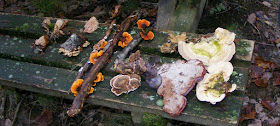The 5 November fungi foray to the Forest of Loches was led by Didier Raas, a pharmacist from Loches. He leads outings a couple of times a year to teach anyone who chooses to turn up about how to identify mushrooms, and best practice when foraging. Outings are often in partnership with the Association de botany and de mycology de Sainte Maure de Touraine. They are advertised in the local press and at the Tourist Office in Loches. He's leading another one today in the Forest of Preuilly, from 9.30 am.
Fungi foragers gather in the car park of the Pyramide de Saint Quentin.
A dry rot Serpulaceae (Fr. mérule) growing on a stump. Not the species that can damage your house.
Cream coloured 'milk' forming on the gills of Oak Milkcap Lactaria quietus (Fr. Lactaire tranquille) after they are touched. This species smells strongly of bedbugs or wet laundry.
A slime mould Myxomycetes (Fr. Myxomycète).
A curtain crust Stereum sp (Fr. une stérée).
Dominique explaining how to identify Death Cap Amanita phalloides (Fr. Amanite phalloïdes),
the most toxic mushroom in the forest.
Bicoloured Deceiver Laccaria bicolor (Fr. Laccaire bicolore).
These can be found everywhere, in the forest and in damp grass in light woodland such as orchards.
They are abundant and a mushroom you most likely see every day.
These can be found everywhere, in the forest and in damp grass in light woodland such as orchards.
They are abundant and a mushroom you most likely see every day.
Mostly bracket fungi. Includes Strict-branched Coral Ramaria stricta (Fr. Clavaire dressée),Variable Oysterling Crepidotus variabilis (Fr. Crépidote variable), Turkey Tail Trametes versicolor (Fr. polypore versicolore) and Lingzhi Mushroom Ganoderma lucidum (Fr. Reishi). The latter is made into a syrup used in Traditional Chinese Medicine for the usual plethora of ailments.
The mushrooms are laid out in their family groups at the end of the outing to be identified.
Amanita spp left foreground, Russula spp right foreground.
Didier showing the two groups of mushrooms that have pores (not gills, like 'supermarket' mushrooms). Bracket fungus on the left, Bolete on the right.
Didier holding an Edible Cep Boletus edulis (Fr. Cèpe de Bordeaux) and explaining how to recognise this prized edible species. Other edible boletes on the left hand end of the table.
************************************************
For details of our private guided tours of chateaux, gardens, wineries, markets and more please visit the Loire Valley Time Travel website. We would be delighted to design a tour for you.
We are also on Instagram, so check us out to see a regularly updated selection of our very best photos.
We are also on Instagram, so check us out to see a regularly updated selection of our very best photos.












2 comments:
I like the name "Turkey Tail" for Trametes versicolor... it is actually far more descriptive than the "Artist's Pallet" I grew up with.
Trametes versicolor was the first scientific name I ever learnt... along with Phallus impudicus....
I like Turkey Tail better, and I think Artist's Palette is applied to some other species. And of course Phallus impudicus was first -- irresistible.
Post a Comment